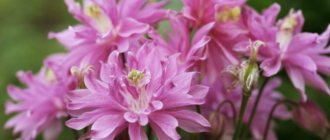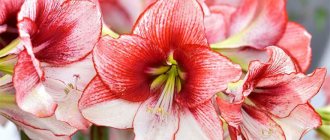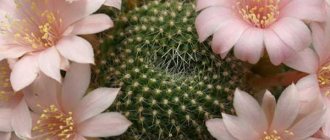The unusual flowers of hippeastrum on a high peduncle will not leave indifferent even those who are not keen on flowering plants. Although it is often confused with amaryllis, they belong to different genera of the same family.
The unusual flowers of hippeastrum on a high peduncle will not leave indifferent even those who are not keen on flowering plants
Botanical description of hippeastrum
The name of the bulbous plant (Hippeastrum) of the Amaryllidaceae family is translated into Russian as “horseman” and “star”. The shape of the bulb is round, with a diameter ranging from 5 to 10 cm. The surface of the linear leaf plates is grooved, the lower part is keeled. They grow up to 70 cm in length and up to 5 cm in width. Usually colored green, but there are varieties with a purple color.
The leafless peduncle is decorated with an umbrella-shaped inflorescence with orange, pink, white, dark or bright red large funnel-shaped or tubular flowers.
Catalog of types and varieties of indoor and garden hippeastrum
Thanks to breeders, 90 species, as well as more than 2,000 varieties and hybrids of this bulbous plant, were created by crossing.
Hippeastrum with red flowers is the most popular because it can lift your spirits in winter. The variety of varieties has led to the creation of garden classifications that differ in the shape and color of flowers. Some of them are grown indoors, while others are grown in open ground.
We also recommend reading:
16 most popular indoor plants Physalis: description of species and varieties, technology for growing from seeds Spruce in landscape design: the best ornamental varieties and characteristics of cultivation Kalanchoe: description of types and characteristics of care at home
There are several methods to catalog a bulbous plant:
- Flower size.
- The amount of overlap of the petals with each other.
- Similar to orchids.
- Structure (terry and non-terry).
The most successful is the hippeastrum with red flowers.
Breeders classify the size of the buds into 3 main groups:
- Small-flowered.
- Large-flowered.
- Medium flowered.
Depending on the direction of selection, classification occurs into the following varieties:
- Tubular;
- Leopoldia;
- Terry;
- Belladonna;
- Miniature;
- Regina;
- Orchids.
Hippeastrum Lady Jane
Lady Jane
It is considered the most delicate species with flowers up to 20 cm in diameter with wavy edges. Peach color. The corrugated surface has yellowish-pink veins.
Barbados
It is one of the brightest representatives of hippeastrum, having red-burgundy flowers, in the center of which there are white lines.
Hippeastrum Barbados
Papilio Butterfly
It is distinguished by the elongated structure of the bulb. The appearance of the buds is similar to soft cream or greenish-yellow butterflies with red lines located in the central part of each petal. It was this similarity that formed the basis for the name of the variety.
Spotted
The petals are covered with small red speckles. The rest of the area has a greenish and creamy color.
Diseases and pests
Hippeastrum is often affected by fungal burns, powdery mildew and red rot. It is also often attacked by aphids and spider mites. Mealybugs and scale insects may appear. To get rid of them, special insecticidal solutions are used.
To understand what is wrong with a flower, examine it carefully.
- If you see red spots on the bulb or leaves, then this is a fungal burn. Dig up the bulb and cut off any affected areas. The cut areas are treated with a solution of chalk and copper sulfate (ratio 20:1). After this, the onion should dry in the open air for a week. And then it can be planted in soil that is first treated with fungicides.
- The white coating on the above-ground parts of the plant is powdery mildew. To get rid of it, you can treat the flower with solutions sold in gardening stores.
- Rotting bulb scales and drooping foliage indicate rot. In this case, all sore spots are cut off, the bulbs are taken out and dried well. Then they are planted in a new pot with fresh soil, which is pre-treated with Fundazol.
Bulb diseases
Dangerous signs are cessation of leaf growth and development. This is ok in winter or autumn, but not in summer. The disease is indicated by underdeveloped leaf blades and a low peduncle.
- Obvious signs of bulb disease are black and brown spots and softness.
- The worst thing is rot on the plant and small insects, excess water.
- Another important signal is that the bulb has tilted and is supported by the remaining roots.
The following resuscitation measures must be taken:
- The bulb is removed from the pot along with the earthen lump and examined.
- Based on the results, certain actions are taken - perhaps the roots are simply waterlogged, they should be slightly dried along with the soil.
The advantage of hippeastrums, like all bulbous plants, is the ability to stay outside the ground for a long time. The bulbs lie perfectly in a dark, cool place, waiting for planting. However, if signs of damage are present, the damage must first be assessed.
The lesions can be located only on the top layer of scales, and then it is enough to remove with a sharp knife to the depth of a couple of scales, if necessary, throughout the entire bulb. Afterwards it is treated with a solution of potassium permanganate or any fungicide. It can also be treated with a solution of brilliant green.
- After one and a half to two weeks, you can keep the bulb in a place isolated from light or on a shelf in the pantry - they will dry out.
- Such actions will protect against further spread of the disease and decay.
- As time passes, the bulb can be planted in another container and new soil.
- When you plant hippeastrum, try to place the damaged area above the ground.
Measures to treat the disease can be continued if suddenly it was not possible to overcome it the first time. I remove the affected roots and the bottom of the bulb, and the cut is processed. Drying the hippeastrum bulb is very important.
What to do if the bulb loses all its roots
It may happen that the bulb loses all its roots, but even in this case the plant can be saved. Of course, if the bulb inside is healthy.
- The damaged areas are cleaned again and treated with already known fuginicides.
- After thoroughly drying, the bulb is placed in a dark place and stored there until the end of winter.
We can say that it survives the winter not in the soil and container, but on a shelf. It can be replanted in early or mid-summer. Rooting stimulants will accelerate growth and development - you need to treat the bulb with them before planting. If you have potassium permanganate on hand, dilute it with water and keep the onion in the solution - it will both disinfect and stimulate growth.
To control root formation, the bulb can be planted in a transparent plastic glass (a 500 ml container is suitable). The soil for it is moistened vermiculite with a small amount of root formation stimulator.
The bulb does not need constant watering - the plastic prevents evaporation, the bulb on top prevents water from evaporating. Place the container itself in a bright room, avoiding places illuminated by direct sunlight.
There are times when it took six months to wait for signs of bulb viability. Whatever happens, don’t despair. When the bulb has turned slightly green and gained elasticity, it means that the plant will still delight you with wonderful flowers.
The volume of water and its regularity are regulated independently depending on the microclimate - humidity level, ambient temperature, concentration of leaves. In this simple way you can stimulate the hippeastrum to bloom when you need it.
Planting hippeastrum
Purchasing planting material is not difficult, since bulbs are available in almost all flower shops. Before purchasing, it is recommended to carefully examine the bulbs so that they are not damaged, otherwise additional time will be needed for their treatment or the hippeastrum will die altogether.
Timing and technology for planting hippeastrum at home
Since the best time for forcing indoor flowers is autumn or spring, it is advisable to purchase bulbs at this time. Most often, mixes of bulbs are sold in retail outlets.
The purchased planting material is already prepared for flowering. The required steps are as follows:
- Initially, you need to select a suitable container, which should be narrow but tall.
- Filling the planting pot with suitable soil, which can be purchased at the store or made independently from turf soil, humus and sand.
- Deepening the bulb 2/3 of the way.
The pot should be placed in a place at room temperature. You don’t need to water the soil until the sprout appears.
Preparing hippeastrum for winter (video)
When and how to plant garden hippeastrum correctly
The beautiful flowers of hippeastrum fascinate many gardeners, forcing them to purchase this plant. Regular flowering is possible only with proper implementation of all the features of caring for it.
Before planting the bulbs on the site, they require special preparation (forcing). To do this, in the fall it should be placed in a dark place with a low temperature. The so-called hibernation lasts up to three months. Watering is not required at this time. Except for the danger of the roots drying out. In this case, you need to water a little.
With the onset of spring, when the threat of night frosts disappears, the material must be planted in open ground. First, the peduncle appears and the flower blooms. To avoid the plant wasting energy on forming seeds, the faded bud must be cut off along with the peduncle. After this, leaves begin to grow and babies appear on the bulb. Before the onset of autumn frosts, the bulb must be dug up and sent for forcing. Garden hippeastrum loves nutritious and loose soil.
Transplantation and propagation
Hippeastrum needs to be replanted periodically once every three or four years. This will help protect the flower from degeneration.
After the end of the flowering period, it, along with all the soil in the previous pot, is moved to a new container filled with fresh fertile earthen substrate.
A new container is selected so that the distance from the bulb to the bottom and walls is up to two centimeters, or slightly less.
Under no circumstances should the tender roots of the plant be exposed to the ground. They must be handled with particular care. In a new container, the bulb should be placed so that one third of it is located on top of the ground.
Recommendations for planting:
- The soil is replaced along with plant replanting once every one or two years. It is preferable to replant hippeastrum in April or May - a month after the end of flowers. Young plants are replanted as needed, but the top layer of soil is changed once every year.
- The diameter of the pot does not need to be increased significantly. Hippeastrums bloom much better in small containers.
- In order to understand whether a pot is suitable for your plant, you need to place a bulb in it - the distance from the walls to the bulb should be about 2 cm. Depth is of great importance, since space is needed for the development of the root system.
- Ceramic pots are a priority, because the material promotes air exchange. Light pots are not suitable for the flower - it has really powerful stems and leaves, so with a slight impact the container can tip over.
- The drainage layer is no less important. It may consist of expanded clay, small pebbles - gravel. Several sticks of long-lasting fertilizer can be placed on the drainage covered with a layer of soil. If we talk about soil, then it includes leaf humus, sand, turf and humus soil.
- The roots are not cut off when transplanting. If there are sick or dead, they are removed by sprinkling the damaged area with charcoal. Tiny daughter bulbs are left for quick reproduction, and removed for generous flowering of the mother plant.
- Each type requires its own pot. If all care recommendations are followed, hippeastrum blooms 3 or 4 years after planting.
- Plant babies usually delay flowering in a number of varieties. They will form faster if you “settle” the plant in a spacious pot. Hippeastrum will prefer the vegetative method of propagation to the seed one.
- Plant the bulbs with their roots down in well-drained soil with sufficient humus content. The roots are left behind. In large containers, you can plant several bulbs at once at a distance of a decimeter. The soil in the pot is compacted, leaving about a third or half of the bulb on the surface.
Before planting, you will have to remove dead dark brown and dry bulb scales.
This needs to be done for the following reasons:
- If the plant has been living with you for a long time and you are replanting it, then removing non-viable tissue until green stimulates the life processes of the plant, which is still overwintering.
- Store-bought plants should be treated with caution. Pathogens, traces of rotting and young bulbs can be found under dead scales. In the latter case, they are separated from the mother plant.
Afterwards, the bulbs are treated with substances that prevent the occurrence and spread of fungal diseases (a solution of potassium permanganate can be used) and dried for 24 hours.
Suspicious areas are smeared with brilliant green or the drug “Fitosporin” and also dried. After planting, the plant is moistened with water and placed in a warm place with good lighting.
Gallery: hippeastrum (53 photos)
Features of caring for garden hippeastrums
In the warm season, the plant can be planted in open ground so that it can rest and gain strength. This crop tolerates sunlight well, but it is better to plant it in a place with openwork shade. In addition, the soil on the site must be well-permeable to moisture to avoid stagnation.
Although the plant does not require special care, it is important to ensure that no weeds grow nearby and remove them in a timely manner. The soil needs to be loosened regularly to prevent a dense crust from forming.
The distance between the bulbs should be at least 15 cm, and 5 cm between the children is enough. The bulbs must be buried in such a way that they protrude 1 cm above ground level. If the weather is moderate, you should water once a week. During hot days, increase watering by 2 times.
The process of caring for hippeastrum includes two main states - the flowering period and hibernation, which preserves the plant until the next flowering. Given the characteristics of the bulbous flower, it does not require significant effort.
Hippeastrum after flowering and during dormancy
When a houseplant finishes flowering, you should wait until the last inflorescences and peduncle dry. Then the arrow of the peduncle is cut to the remaining sprout of 3–4 cm. In the summer, the hippeastrum may re-bloom. If it is approaching October, then the flower needs to prepare all the necessary conditions for the dormant period.
With a gradual reduction in watering, cut off dried stems and leaves. The plant is transferred to a cool and shaded room. The flower pot is stored on its side. During hibernation, the hippeastrum is not watered or fed until February . Closer to spring, he is again transferred to a warm room and given the usual care.











